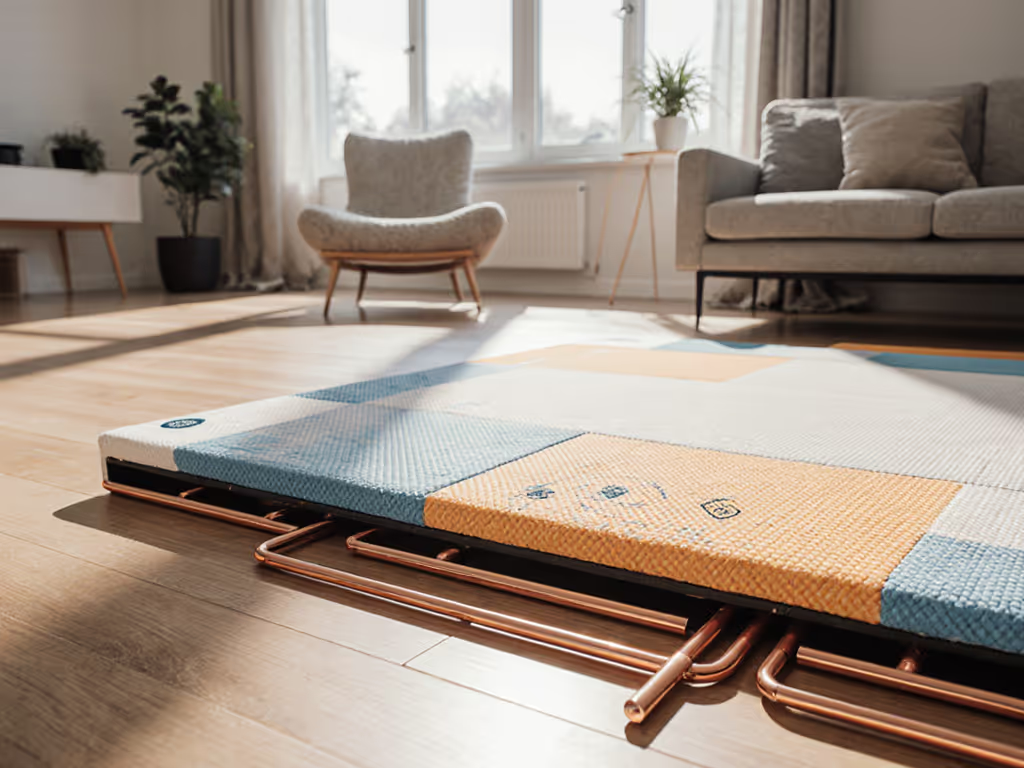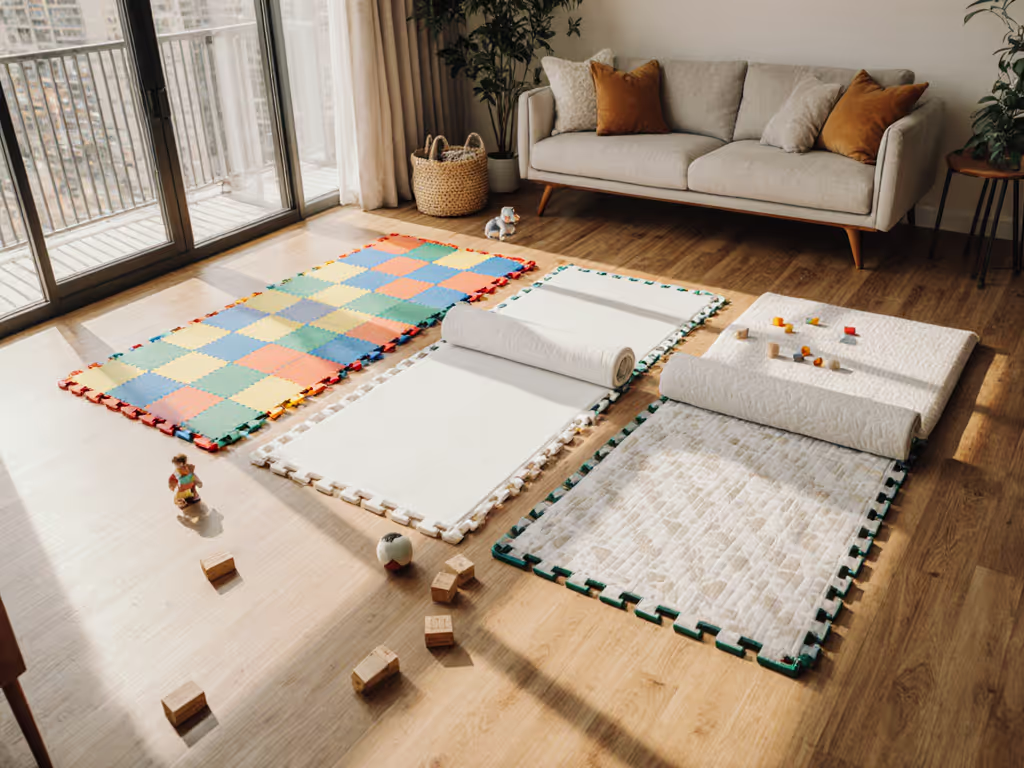
Waterproof vs Fabric Play Mats: Safety & Cleanability Compared
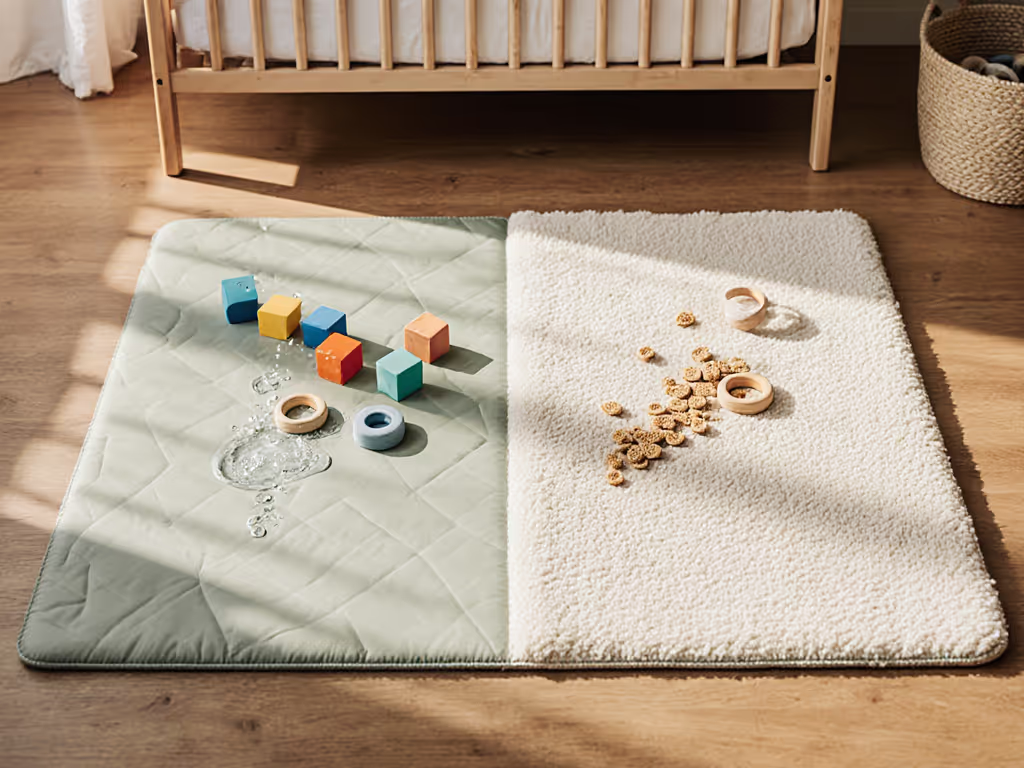
As a parent navigating the overwhelming world of baby play mat options, the core question isn't just about softness or style, it's a fundamental safety and practicality test: 'Will this mat keep my child safe while surviving the daily chaos of spit-up, purees, and pet hair?' That is why the waterproof play mat vs fabric debate matters so deeply. It is not merely about preference; it is about matching your actual living space, floor type, and peace of mind with materials that deliver on non-toxic claims and effortless cleaning. I've learned this firsthand (our nursery's initial "new" smell wasn't just novelty; it was off-gassing). Once I started requesting test reports, those headaches (and the chemical haze) quietly vanished. Transparency isn't a vibe, it is a feature. Let's cut through the confusion with data, not marketing.
Decoding the Material Maze: Why "Non-Toxic" Isn't Enough
Before comparing waterproof and fabric mats, we need plain-language clarity on what actually makes a non-toxic play mat materials claim meaningful. Many terms sound reassuring but lack teeth:
- VOCs (Volatile Organic Compounds): Gases emitted from certain solids or liquids (like new mats). Short-term exposure can cause headaches or irritation; long-term risks are less defined but concerning for developing infants. Look for: Greenguard Gold certification (limits VOC emissions) or explicit third-party test reports measuring specific compounds like formaldehyde.
- Off-gassing: The process of VOCs releasing into the air. "Low-VOC" isn't regulated. Demand specific test data. A 2023 study by the Ecology Center found 30% of baby mats exceeded safe phthalate levels despite "non-toxic" labels.
- "Phthalate-Free" or "BPA-Free": These are table stakes. Avoid mats listing "fragrance" or "other ingredients", full material disclosure is rare but critical.
Critical Unknown: Most certifications (like CPSIA) focus on ingestion hazards (lead, choking), not inhalation risks from off-gassing. Always pair compliance with air-quality testing data. Show the test report.
Waterproof Mats: The Wipe-Clean Workhorses
Waterproof mats (typically made from TPU (Thermoplastic Polyurethane), natural rubber, or certain XPE foams) prioritize easy cleaning and stain resistance. They are engineered for high-mess zones.
Safety & Materials Breakdown
- TPU Mats: Chemically inert, and Greenguard Gold-certified options (including some XPE foams) show near-zero VOC off-gassing. They avoid formamide (a carcinogen linked to some EVA foams used in cheaper mats). Risk tier: Low (if certified). Uncertified TPU may still contain slip-resist additives with unknown emissions.
- Natural Rubber Mats: Hypoallergenic and biodegradable, but check for latex (a common allergen). Requires acid-washed processing to remove irritants. Greenguard Gold testing confirms low VOC profiles. Risk tier: Low to Medium (allergen risk).
- EVA Foam Mats: Proceed with extreme caution. Genuine EVA foam (not to be confused with expanded polyethylene) often contains formamide to soften density. The EU classifies formamide as a reproductive toxin. Risk tier: High unless certified formamide-free (<200ppm per EU standards). Many U.S. mats lack this testing, always verify.
Cleanability & Practicality Wins
Waterproof mats shine for easy clean play mat needs:
- Spills bead up; a damp microfiber cloth removes stains in seconds (no scrubbing).
- Resistant to pet hair, crumbs, and moisture, ideal for homes with hardwood/tile floors where leaks spread.
- Thicker options (0.4+ inches) provide cushioning without compressing permanently.
Real-World Drawback: Thin mats (<0.3") can curl at edges on radiant floors or slip on super-smooth tile. Opt for mats with textured non-slip backing (like rubber dots) tested for hardwood compatibility. Noise reduction is minimal, dropped toys will echo in apartments.
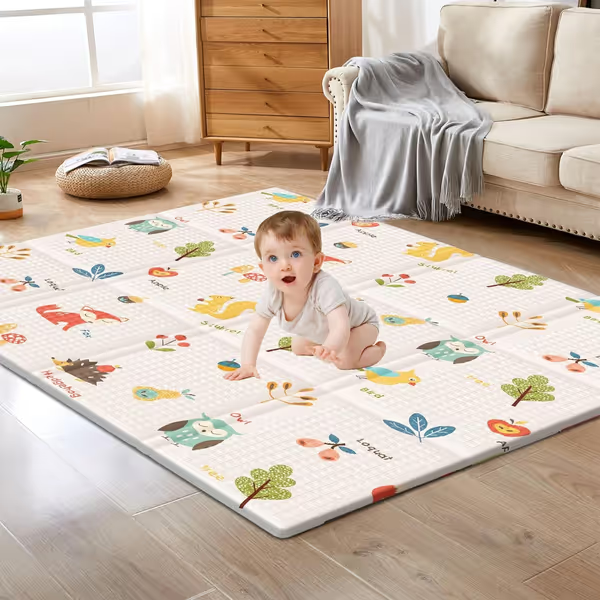
Foldable Baby Play Mat
Fabric Mats: The Breathable, Cozy Contenders
Fabric mats (usually organic cotton, hemp, linen, or bamboo) prioritize softness, breathability, and aesthetic harmony. They are beloved for sensitive skin and neutral decor.
Safety & Materials Breakdown
- Organic Cotton Mats: GOTS-certified (Global Organic Textile Standard) cotton ensures no pesticide residues or toxic dyes. Crucially, the padding matters most, many use polyester fiberfill (often untested for VOCs). Risk tier: Low to Medium (padding unknowns).
- Hemp/Linen Mats: Naturally mold-resistant and low-VOC. Hemp requires less water to grow but shares cotton's padding vulnerability. Risk tier: Low with certified organic padding.
- Bamboo Mats: Often blended with polyester. True bamboo viscose involves chemical processing, demand OEKO-TEX certification confirming no residual solvents. Risk tier: Medium (processing chemicals).
Critical Gap: Fabric mats cannot be waterproofed without coatings like PFAS (forever chemicals). "Water-resistant" claims usually mean a thin TPU layer, which defeats the breathability benefit. True waterproofing is not possible with natural fibers alone.
Cleanability & Practicality Realities
Fabric mats excel in breathability but face waterproof activity mat limitations:
- Spot-cleaning only for most (except machine-washable cottons like Toddlekind's). Purees or urine seep into padding, causing odors.
- Require immediate blotting + air-drying to prevent mold, impossible during rushed diaper changes.
- Thick padding (great for tummy time) compresses under furniture/strollers, leaving permanent dents.
Trade-off Alert: Machine-washable mats (like cotton throws) lose softness after 5-6 washes. For homes with pets or frequent spills, fabric's aesthetic appeal comes with daily maintenance stress.
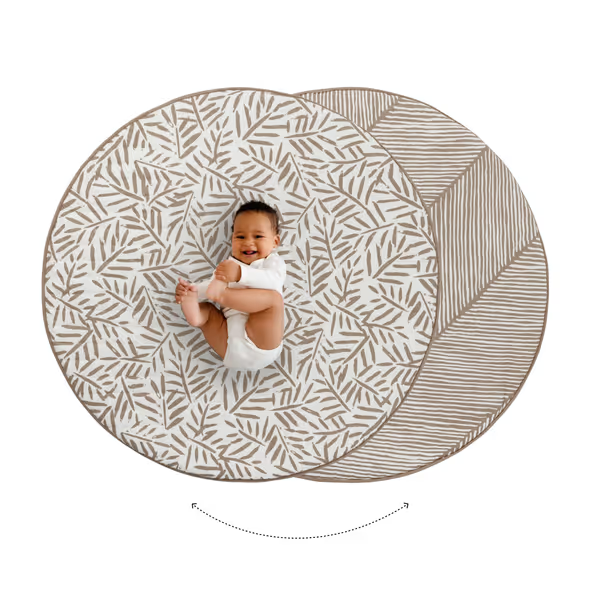
Toddlekind Organic Cotton Reversible Play Mat
Head-to-Head: Safety, Space & Sanity for Real Homes
Let's translate specs into your lived reality. Here is how these mats perform across your top pain points:
| Factor | Waterproof Mat (TPU/XPE) | Fabric Mat (Organic Cotton) |
|---|---|---|
| Floor Safety | Secure grip on hardwood; no slipping (tested) | Slips on laminate; requires rug/floor mat underneath |
| Clean Speed | 10 seconds for spills; no washing | 5+ minutes spot-cleaning; machine wash weekly |
| Odor/VOC Risk | Near-zero if certified; request test reports | Low if uncoated but padding may off-gas |
| Small-Space Fit | Rolls thin; stores under sofa (0.5" when folded) | Bulky when folded; needs closet space |
| Toddler-Proofing | Scratches from pet claws resist well | Pet hair embeds; stains visible immediately |
| Lifespan | 2+ years (no compression dents) | 12-18 months (padding flattens) |
"Transparency is a feature, not a vibe or hint." Too many brands hide padding materials or skip VOC testing. Always ask: "Can you share the full third-party test report for VOCs and formamide?"
Your Decision Checklist: Beyond the Hype
Don't fall for "eco-friendly" claims without proof. Use this framework:
- Verify Certifications: Greenguard Gold > CPSIA alone. Prop 65 compliance is minimal (just discloses chemicals, doesn't limit them).
- Demand Padding Details: "Natural fibers" is meaningless. Ask: "What is the exact composition of the core padding?" (e.g., "GOTS-certified organic cotton batting").
- Test the Non-Slip: Place a sample on your actual floor. Does it shift when tugged?
- Check Cleanability: Drip soy sauce on the mat. Does it wipe clean in 10 seconds? Real waterproofing shows immediate beading.
The Verdict: Where Your Priorities Lead You
Choose a waterproof play mat if you:
- Live in a small apartment with hardwood/tile floors
- Need instant cleanup for blowouts or pet messes
- Prioritize verifiable third-party VOC testing
- Want one mat from newborn to toddler (no rebuying)
Choose a fabric mat if you:
- Have carpeted floors (reduces slipping risk)
- Value breathability for hot climates or sensitive skin
- Don't mind weekly machine washing
- Prioritize aesthetic blending over emergency cleanups
Neither wins outright, it hinges on your space and stress points. But in my home, after that VOC-filled nursery phase, I realized: the best mat isn't the softest or cheapest. It is the one whose maker hands you the test report without hesitation. That is the transparency families deserve. For deeper material comparisons, I have compiled a non-toxic play mat safety checklist of exactly what to ask brands before buying, no fluff, just the safety questions that matter.
Related Articles

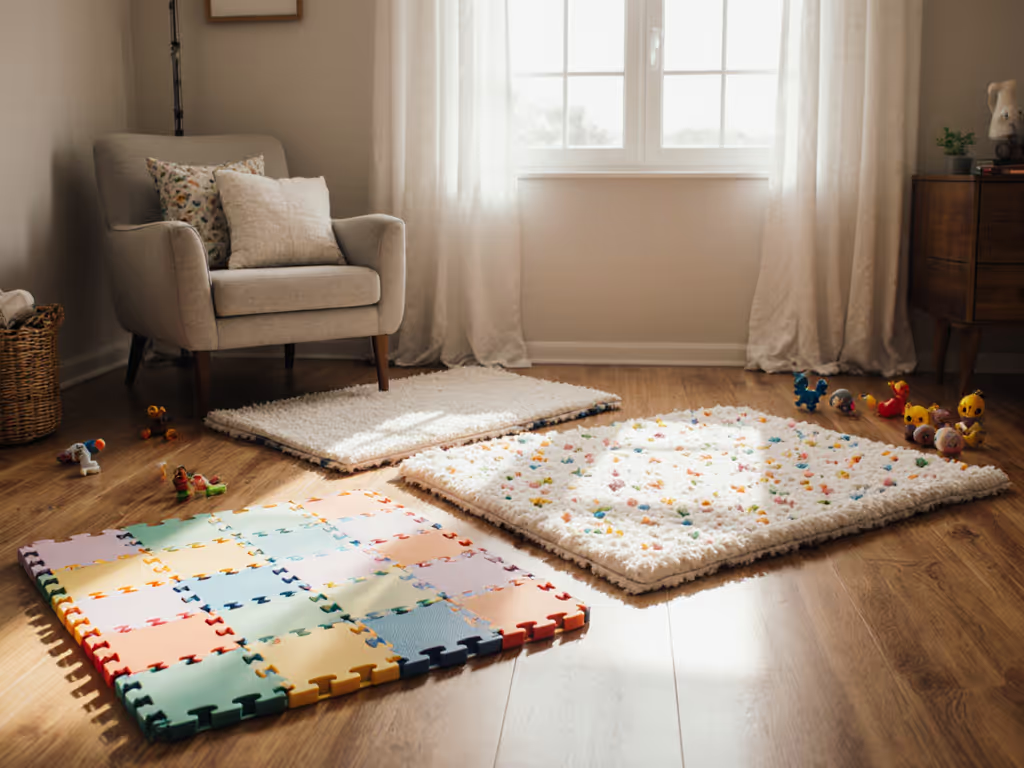
Down Syndrome Play Mats Compared: Lasting Value Guide

Postpartum Recovery Play Mat: Mom-Friendly Picks

Scrub-Tested Pet-Proof Baby Play Mats
